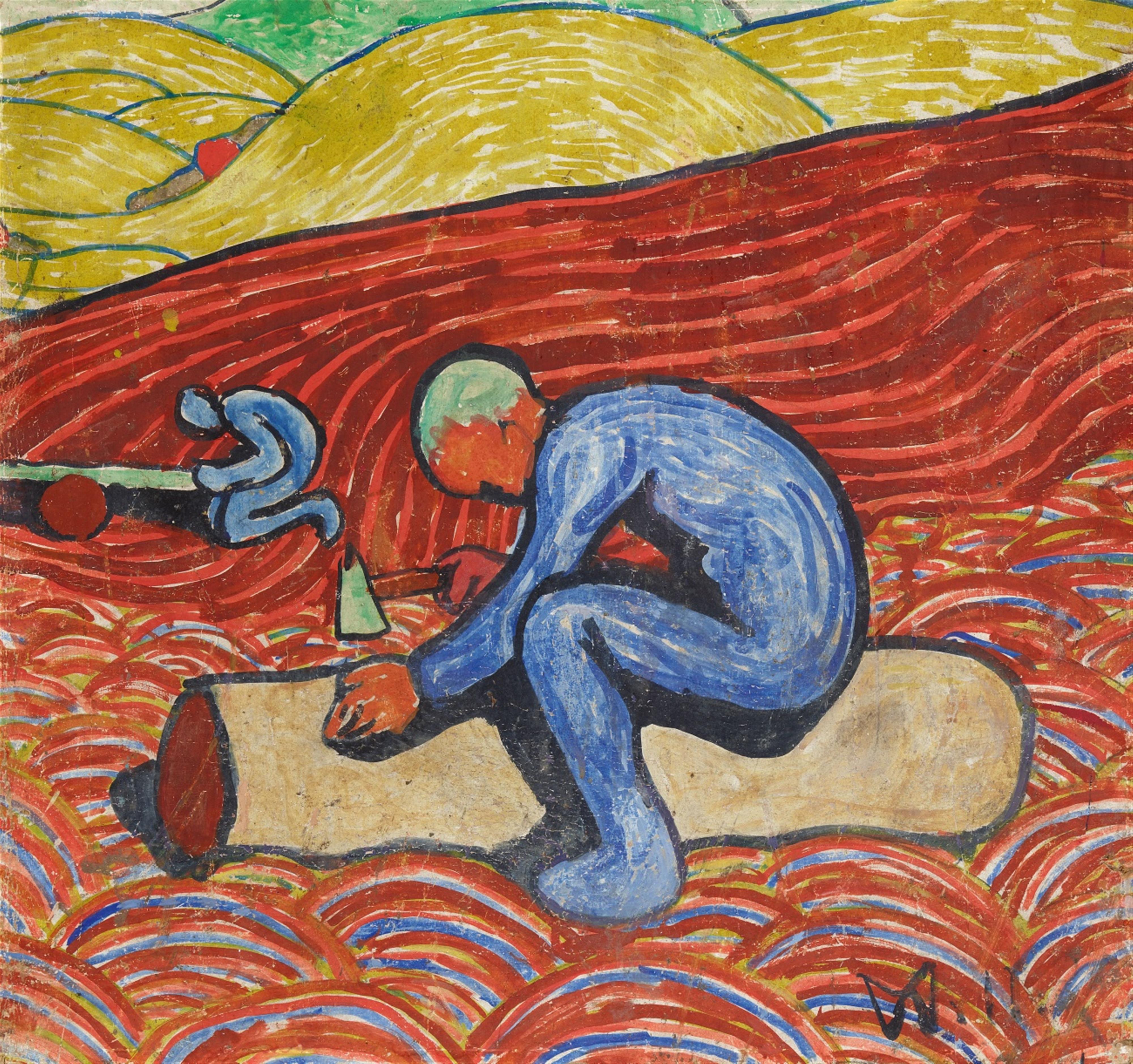Wilhelm Morgner
Die Holzarbeiter
1911
Tempera on card 56.5 x 60.2 cm Framed under glass. Monogrammed with signet and dated 'WM. 11" in black lower right. - Inscribed with Tappert number "77" (cropped) and "MORG 123" in black on top of backside. - Isolated minor losses of colour. The left and the upper margin were trimmed due to war damage in 1945.
This work on card, part of which was unfortunately decimated during the Second World War, belongs to a small series of paintings created in 1911 by the Expressionist Wilhelm Morgner. These works depict labourers who carry out their specific tasks while merging with the surrounding landscape into a swirling network of lines made up of dots and fields of colour. The divisionist application of the brushstrokes clearly points to the work of Van Gogh, without neglecting what is characteristic of Morgner's own work. He created paintings such as “Die Steinbrecher” (Weihs/Tappert 114), the “Heuernte” (Weihs/Tapper 88), “Mann mit blauer Karre in ornamentaler Landschaft” (Weihs/Tappert 95) or “Der Holzarbeiter” (Weihs/Tappert 112) - where the lost pendant to our composition is handled as an independent motif (see exhib. cat. Ins unermesslichste Vielleicht, op. cit., cat. no. 4). “The artist believed that spiritual forces manifest themselves in the material world. His goal was to capture these forces visually - whether representationally or non-representationally was of secondary importance for him, in the case of this subject matter which lay beyond the visible anyway,” is how Friederike Weimar explains the thoughts Wilhelm Morgner expressed to his Berliner patron and collector Georg Tappert (Weimar in: op. cit., p. 85). On 10 November 1911 Morgner described to him the process of creating his works: “When I painted the woodcutters, for example, my head was burning and then all my skin was white hot, so that I couldn't hold it next to a cold object without feeling intense pain. Then I had a feeling as if what was deepest inside me was being turned to the outside and the outermost turned inside, and then the reverse again. At the same time I also had a very strange feeling, I don't know what I should call it. A feeling of happiness is too stale and awkward to express it. With my recent pictures I've felt this way every time. I have good reason not to say this to anyone, because otherwise people would always tell me I'm crazy. I know that, of course.” (cited in Knupp-Uhlenhaut, op. cit., p. 30).
Our work stands in an important context within his limited oeuvre and is from what is surely the most interesting phase of the Expressionist Morgner, who died at a young age and whose works are now to be found in the collections of prominent museums.
Catalogue Raisonné
Tappert 77; Weihs/Tappert 77 a
Certificate
We would like to thank Walter Weihs, Soest, and Andrea Witte, Münster, for additional information.
Provenance
Kunsthandlung Thiell, Soest (1979); Private possession, North Rhine-Westphalia
Literature
Will Frieg, Wilhelm Morgner, Junge Kunst, vol. 12, Leipzig 1920, with illus. (untrimmed); Harald Seiler, Wilhelm Morgner, Recklinghausen 1958, p. 28 ff., cf. illus. p. 25 (Holzarbeiter, charcoal drawing), p. 28 (Holzarbeiter 1911, oil/canvas); Christine Knupp-Uhlenhaut (ed.), Wilhelm Morgner, Briefe und Zeichnungen, Soest 1984, p. 28 ff., cf. illus. p. 30 (Studie zu den Holzfällern II, chalk drawing); Friederike Weimar, Ein Weiterschwingen meines Ichs, etwa wie der Schall, in: Karsten Müller (ed.), exhib. cat. Hamburg 2015, Ins Unermesslichste Vielleicht. Wilhelm Morgner. Malerei 1910-1913, p. 85 ff. cf. illus. 1 (Studie zu den Holzfällern II, chalk drawing), cf. illus. 4, n. pag. (Der Holzarbeiter, oil/canvas)

